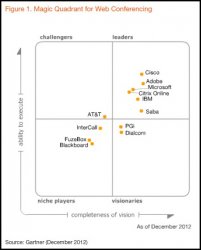Web conferencing Magic Quadrant 2014
 Gartner quietly released their updated 2012 Magic Quadrant for Web Conferencing this month. I didn’t see a press release from Gartner, but I saw the first vendor press release mentioning inclusion in the chart. If past years are any guide, we can expect to see more such press releases from the other vendors.
Gartner quietly released their updated 2012 Magic Quadrant for Web Conferencing this month. I didn’t see a press release from Gartner, but I saw the first vendor press release mentioning inclusion in the chart. If past years are any guide, we can expect to see more such press releases from the other vendors.
Gartner sells the Magic Quadrant report as part of its services for clients, so I can’t give you a free link here or go into detail about their findings. But they did privately share the report with me and gave me permission to publish the graphic for you. Here it is:
As you can see, the only changes in the vendor list are that Fuzebox replaced iLinc as a niche player and positions have changed only slightly. AT&T is the only vendor to change quadrants, and that’s by a small amount. iLinc is out because Gartner required mobile access and iLinc did not meet their test.
As I wrote in my post about the 2011 Magic Quadrant, these graphical summaries always cause controversy in whatever industry segment Gartner covers. Gartner has very specific criteria for which vendors they include and exclude, and the factors they use to position vendors merge lots of different concepts. Positioning is based on overall coverage of the entire field of “web conferencing” from different products in the vendor’s suite (if applicable) using Gartner’s own priority rankings scheme, which may be (and probably is) different than yours as a user. It also looks at overall company strength and viability, which naturally favors larger enterprise manufacturers.
As I read through the Gartner report, I see that they put emphasis on integration with other systems such as external UCC infrastructure platforms, learning management systems, and room-based videoconferencing systems. You might not care about those factors if you are looking for a standalone webinar platform or web conferencing utility. So take the positioning with a grain of salt.
You might also like









